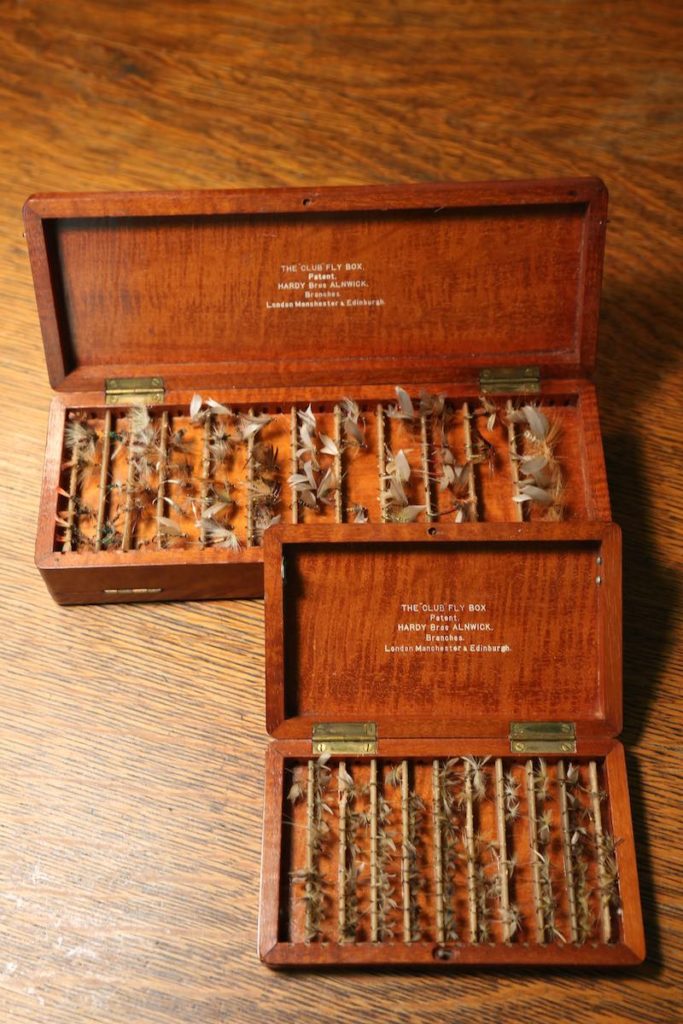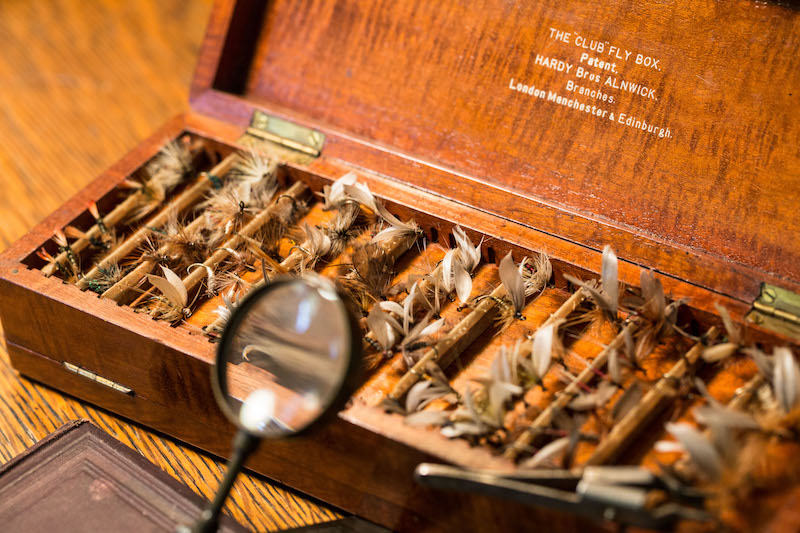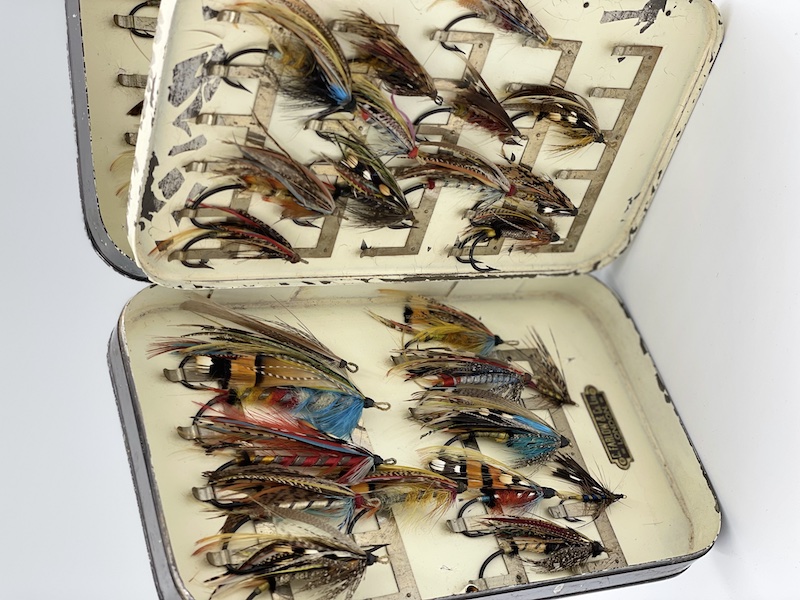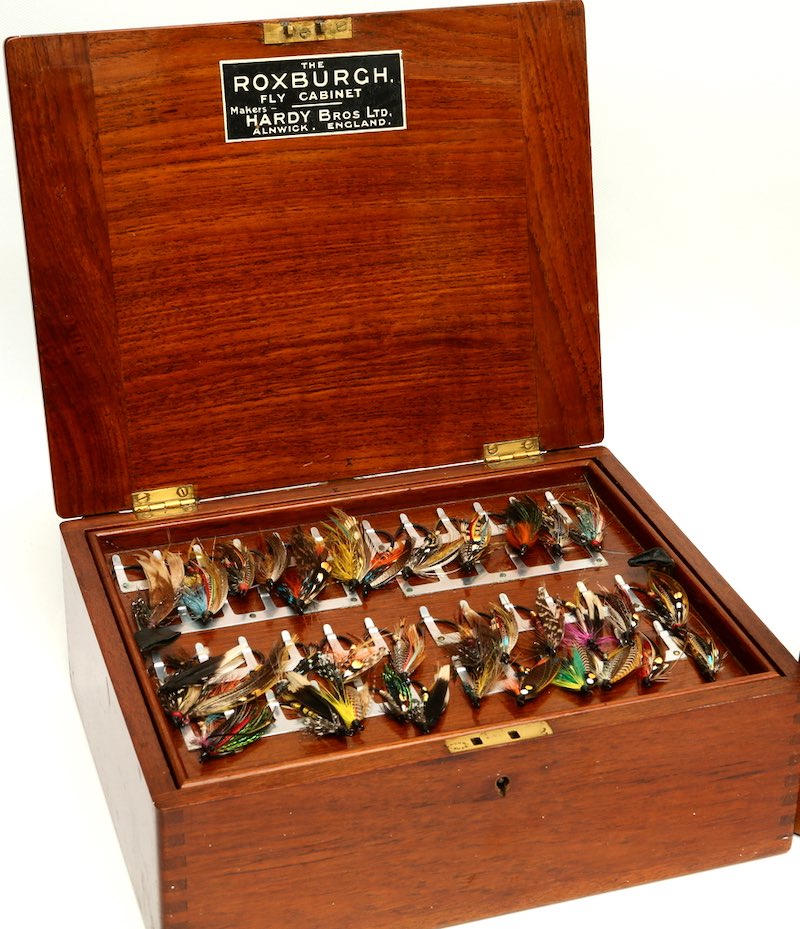
One essential piece of fly fishing gear that has stood the test of time is the fly box. There is a seemingly endless variety of fly boxes on the market today. The design and manufacture of boxes to hold trout and salmon flies have evolved greatly over time with the development of new materials and craftsmanship.

Some of the most collectible fly boxes were made by Hardy’s, with some of the early Hardy Club Boxes for dry flies being some of the rarest. These handsome mahogany boxes engraved with gold type were patented in 1901 and produced in four sizes: the Reservoir, May Fly, and Small boxes, with an additional doubled-side Small variety.

Hardy also later produced some mayfly pattern dry fly boxes with sliding celluloid doors with each compartment labeled for a specific pattern.

The Hardy Neroda box also became popular in a variety of faux tortoiseshell finishes, including oxblood.


Some of the most elaborate boxes in terms of design and quality were reserved for salmon flies. This rare circle fly tin was japanned black on the outside and lacquered white inside. The owner inscribed his record salmon catches on the inside of the lid.

Farlows, Malloch’s, and others produced many black japanned salmon fly boxes, with some including swinging leaves to hold more flies.

The Hardy Roxburgh salmon fly reservoir provides a fine example of the portable wooden reservoirs outfitted for Atlantic Salmon fishing expeditions.

Many fly tiers and retailers also produced small fly boxes to hold the flies and hooks that they sold, including Cummins, J. Bernard, and others. There was even a hallmarked sterling silver circular fly box produced by Asprey and Company in the U.K. (Pictured here atop the tumbler of Scotch, courtesy of Angling Auctions, U.K.).

Perhaps the most famous producer of fly boxes is the Richard Wheatley fly box company in Derbyshire, UK, which has been in operation since 1860, introducing the first fly clips for eyed flies in 1880, the first tin fly boxes in 1890, and the classic aluminum boxes since 1900.
To have anywhere near a complete collection of Wheatley boxes, you would have to collect hundreds of models. Richard Wheatly has also produced collectible custom boxes for fly fishing clubs and special occasions, such as the 50th Anniversary of the American Museum of Fly Fishing.
Steve Woit is the author of “Fly Fishing Treasures: The World of Fly Fishers and Collecting”, a book featuring profiles of 30 experts and collectors and over 800 photographs of rare and collectible fly rods, reels, flies, books, and ephemera.






Some of the most successful flyfishers I have ever encountered (when I was a boy) were the middle-aged and elderly, often rather ragged, local men who fished the Welsh rivers in the 1960s and ’70s with flies with either no name or (for my young, brieflyvery English ear back then, until I learned some) completely unpronouncable Welsh ones tied with feathers from farmyard cockerels and hens, locally rough-shot gamebirds like snipe and woodcock (and, rather less so, pheasants poached from the few remaining County Squires’ estates, ditto moulted peacock tails if a large country house within a 20 to 30 mile radius still kept them), plus some silk and wool from their wives’ sewing boxes / little local haberdashery shop.
As for flyboxes, well, these were definitely NOT the often very pretty and completely over-the-top elaborate things that visiiting English fishers appeared with in due season and stared into sagely though totally ineffectively on reaching their riverbanks.
For these very rough and ready but nothing short of a one-highly-canny-Welshman threat to the continued existence of trout and sea-trout (and, in a few cases, Atlantic salmon, though worm baits tended to be more effective for these), only old pipe tobacco tins would do. The, back then, still very numerous fish didn’t mind a bit, in fact seemed more likely to surrender themselves to Wheatly-less fishers who looked like scarecrows than to the Angling equivalents of Gilbert and Sullivan’s “very model of .a modern Major-General” who appeared on their banks every season.
Do an image search for “old pipe tobacco tins” on Google. A lot of Welsh trout used to go a bundle on bits of dowdy feather and fur pulled out of often quite rusty “Old Holborn” tins. It appears that people collect them these days, but then tend to do that with almost anything and everything now.
Boote, owner of rather too many flyboxes, most of them cheap, local hardware store, nuts-and-bolts partitioned / foam-lined by myself plastic jobs, but a handful much-travel-scraped and -scratched and -dented fancy Wheatly, out.
For years (1970-1990) I kept my flies in 6 different Princess Mary 1914 brass Xmas boxes lined with foam. I just recently put all the flies (315) in a foam lined old cookie tin and put it on eBay. Now I have to try and clean the dried glue from the brass boxes before trying to sell them on eBay also.